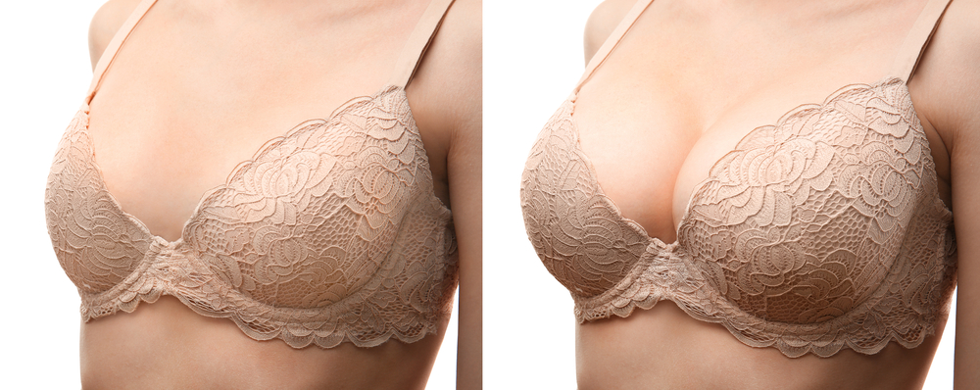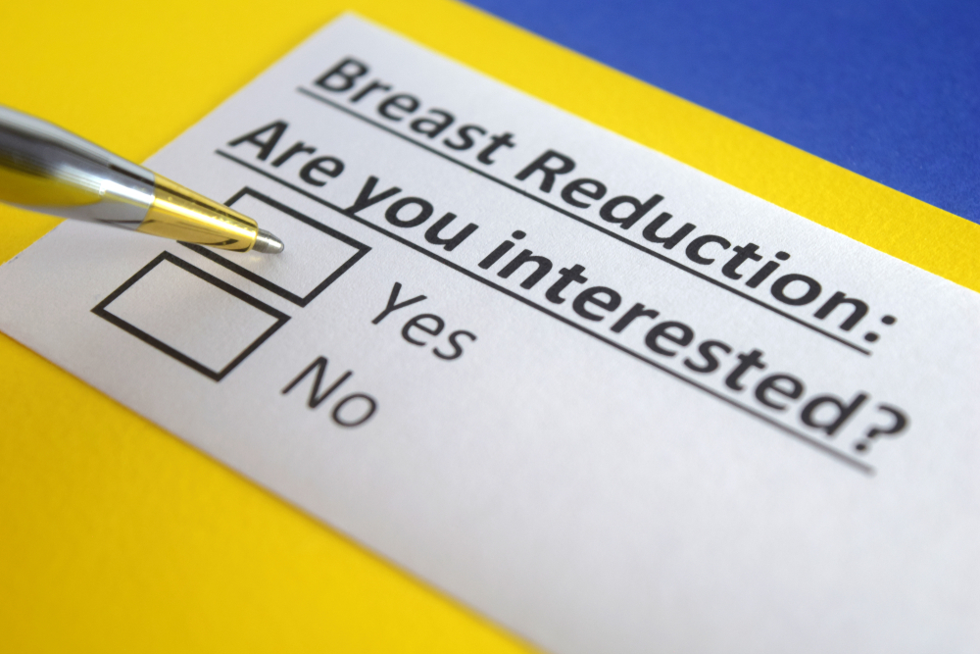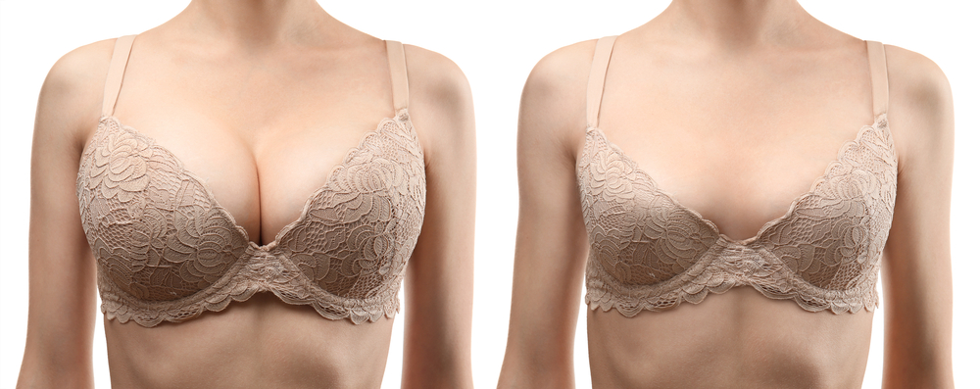Breast reduction- Female
Published on: 16 Oct 2019, 10:52 a.m.
Mr Debashis Ghosh
NHS Consultant
GMC Number: 4657664

Medically reviewed by a licensed NHS consultant
Last updated: 15/08/2019Get Free & Simple Pricing, Procedure & After Care Information from a Licensed Consultant Now
Photo Credit: ShutterStock/ Yeexin Richelle
Table of Contents
What is Breast reduction surgery?
Breast reduction surgery also known as a reduction mammaplasty, is a major surgical procedure which reduces your breast size, weight and augments its shape. The procedure involves removing excess fat, tissue and skin from the breasts.
Breast reduction surgery is used for both cosmetic and medical desires, with large breasts causing a variety of health and emotional problems. In 2018 over 4,409 surgeries were performed on the NHS.
Furthermore, the British Association of Aesthetic Plastic Surgeons’ stated that breast reduction was the second most popular procedure for women, rising over 7% since 2017.
Why is breast reduction performed?
Approximately 1 million women worldwide are affected by large breasts. Breast reduction surgery is performed to help patients overcome these issues.
Large breasts can cause unwanted physical pain for women including:
- Back, neck and shoulder pain
- Skin irritation and rashes under the breasts
- Nerve pain
- Shortness of breath
- Numbness in the fingers.
- Migraine and headaches
A breast reduction can also be performed for cosmetic reasons. These patients often suffer with problems such as:
- Unequal breasts (size and/or shape
- Large breasts causing unwanted attention
- Desire to change the appearance of your breasts
- Difficulty finding bras and clothes that fit.
Breast reduction surgery isn't recommended if you:
- Smoke
- Suffer from diabetes or heart problems
- Are obese
- Want to avoid scars on your breasts
- Are losing weight- if you are currently trying to lose weight, a breast reduction may not be suitable. Weight loss often changes the shape and size of your breasts.
- Will have children soon. If you are planning on becoming pregnant, it is recommended to wait until childbirth isn’t a problem.
During pregnancy your breasts undergo changes in shape, sizes and weight and breast reduction surgery can impact your ability to breast feed. If you are breastfeeding or pregnant you should wait at least 3-6 months after childbirth before having a breast reduction. Speak to your doctor if you are concerned.
If you're thinking about having a breast reduction, it is vital to understand the advantages and disadvantages of cosmetic surgery and be realistic about the results.
If you agree with the above, then generally you are a good candidate for a breast reduction. Consult your doctor to discuss more!
What can a breast reduction achieve?
Breast reduction benefits:
- Reduce breast size
- Remove excess skin
- Potentially reduce the size/position of the nipple and/or areola
A breast reduction procedure is often combined with other surgeries. Patients can be given a breast uplift and/or nipple reduction to improve the cosmetic results. Patients can also combine a breast reduction with liposuction.
Depending on your desired results your doctors may recommend a combined procedure.
What preparations do I need before breast reduction Surgery?
- Stop smoking- at least two weeks before surgery.
- Stop taking aspirin and other anti-inflammatory drugs. Discuss with your doctors before stopping any prescribed drugs.
- Eat lots of balanced healthy meals, which are full of vitamins, minerals and protein. This will help you recover fast.
- Arrange for someone to pick you up from hospital.
- Stop drinking alcohol at least a week before surgery
- Most patients will be required to stop eating and drinking 6 hours before surgery. It is vital to follow your surgeons’ instructions about eating and drinking correctly.
- Stay in good physical shape
- Establish a home recovery area- e.g. buy pain medication, prepare loose clothes, movies and clean towels etc.
Breast reduction Procedure
Before
Before your operation, you will have a consultation with your surgeon. Here you will discuss your desired results and decide which technique and methods to use during surgery.
Your doctor will usually discuss:
- Your previous medical history
- Your current health
- Your desired breast size, shape and appearance
You may also be asked to:
- Complete several medical lab tests
- Get a baseline mammogram
- Have photographs and measruments taken of your breasts.
Before your surgery you will be required to sign a consent form.

PhotoCredit: ShutterStock/Kaspars Grinvalds
During the procedure
1. Anaesthesia
Breast reduction surgery is administered in a hospital or outpatient/day surgery facility.
The surgery is usually performed under general anaesthesia, to send patients to sleep during the entire operation. Although local anaesthesia can also be administered. Your surgeon will recommend the best option for you.
On the day of your surgery, the surgeon will administer your chosen anaesthetic. Before taking you into the operating theatre for the procedure.
2. Skin incision
Once the patient is asleep, incisions are made on each breast. Different types of incisions are used depending on the amount of excess skin. Speak to your doctor to decide which technique is right for you.
Below is a list of incisions your surgeon may use during your breast reduction surgery:
Donut (Circumareolar): Crescent Incision
- A donut incision involves cutting around the whole areola.
- This is the least invasive technique, although it can only remove a small amount of breast tissue.
Lollipop (Vertical) Crescent Incision
- Here incisions are made around the areola, but also an incision is made from the bottom of the areola to the crease under the breasts (also called the inframammary fold).
- The Lollipop incision allows more breast tissue to be removed in comparison to the donut incision.
- So, this technique is favourable with patients who wish to remove a small to moderate amount of breast tissue.
Anchor (Inverted-T) Crescent-Incision
An inverted T breast reduction is the most common technique, involving three incisions:
- Around the areola
- From the areola to the breast crease
- Along the bottom of the breasts (inframammary fold).
An inverted T breast reduction allows for the greatest amount of tissue to be removed and/or reshaping.
Liposuction for Breast Reduction
In rare cases, liposuction can be used to reduce the breasts size.
Liposuction can offer a less invasive procedure. However, liposuction is only administered to patients who desire a small amount of tissue removal, have little-to-no sagging and whose excess skin is largely due to fatty tissue.
3. Breast tissue removal
Excess fat, tissue and skin is then removed from your breasts.
Reducing the size of your breasts to your desired cup.
There are different techniques commonly used in breast reduction surgery, with different techniques affecting your nipple sensation and ability to breastfeed differently.
Tissue removal techniques include:
Technique 1 Pedicles
This technique helps preserve the breasts’ blood supply, nerves and milk ducts, through keeping the nipple and areola attached to a pedicle. This technique prevents patients from losing nipple sensation and/or having complications breastfeeding.
The two most popular pedicle techniques are the inferior and the superior as described below.
Inferior Pedicle Crescent-Incision
- This technique attaches the nipple and areola to a pedicle located below the breast. Where breast tissue is extracted from above and the side of the breasts
- The inferior incision is the most popular pedicle technique, used in combination with an anchor incision. Especially for patients who desire/need a large amount of breast tissue to be removed.
Superior pedicle Crescent-Incision
- This technique attaches the nipple and areola to a pedicle located above the breast.
- Keeping the nipple and areola attached to the top area of the breast allows for tissue to be removed from the bottom and sides of the breast.
- This technique is often used in combination with the lollipop incision.
Technique 2: Free nipple graft
- Here breast tissue is extracted, through removing the entire nipple. Once the breast tissue is removed the nipple is sown back on.
- However, this technique is not common. A nipple graft can cause patients to lose sensations in their nipples and increase their chances of complications when breast feeding.
4. Closing the incisions
Once the excess tissue is removed, the incisions are closed up with stitches and/or sutures. Surgeon may also place drains in your breasts to remove any excess fluid (reducing swelling).
Finally, once the drains and stitches are in place. Your chest will be bandaged, and the surgery is finished.
5. Return to the ward
Once the operation is complete, you will be returned to the ward to recover. As this is an invasive surgery, patients are often kept in hospital for one to two nights.
After the procedure
After surgery, doctors will administer pain medication and antibiotics to reduce discomfort and infection.
As you will not be able to drive immediately after your breast reduction, make sure you arrange for someone to pick you up.
Breast reduction side effects
As with any invasive surgery, there are risks. These include:
- Unwanted scarring
- Complications when breastfeeding
- Deep vein thrombosis, cardiac and pulmonary complications
- Fat necrosis
- Infection
- Loss of breast sensation
- Anaesthesia risks (allergic reaction)
- Bleeding (hematoma)
- Blood clots
- Bruising and swelling
You doctor will discuss these risks in your consultation, along with how they would be treated if any occur.
Breast reduction before and after
PhotoCredit: ShutterStock/ Africa Studio

PhotoCredit: ShutterStock/ Africa Studio
Breast reduction Recovery : Week by Week
1 week after surgery
In the first week, it is common to feel weak with some pain and discomfort. Your breasts will most likely be swollen and bruised.
You may also feel a sensation of pulling and/or stretching in the breast area. Pain medication can be prescribed by your surgeon to reduce any discomfort.
- To reduce swelling, it is recommended to place ice or a cold pack over your breast for 10 to 20 minutes every 1 to 2 hours (for 3 days post-surgery).
- Follow your doctor’s advice and get as much rest as possible. It is recommended to sleep on your back, to help reduce swelling.
- Avoid all sports and exercise even minor aerobic sports.
- Your dressings and tubes must remain on for at least a week, to help your breasts recover fast.
2 weeks after Surgery
- You may experience some itching and dryness in the operated areas as your wounds start to heal.
- Bruising and swelling should subside after 2-3 weeks (along with any discomfort).
- Gauze and dressings are usually removed 5-10 days after surgery. Including any stitches and drainage tubes.
- Patients are then required to wear a surgical bra for several weeks
- Approximately one-week post-surgery, once your bandages and tubes are removed, patients are able to shower. Although you should not take a bath or soak in a hot tub for approximately 4 weeks.
- Try to maintain a healthy diet, reducing your sodium intake and increasing your water intake.
- After about two weeks, you should be able to drive and return to work (depending on what your job entails).
- After two weeks you can slowly increase your physical activity. However, lifting heavy objects and strenuous activity should be avoided for at least 6 weeks.
Long-Term Recovery Considerations
- Strenuous and physical activity can be returned to after approximately 1-2 months. Although it is recommended to avoid swimming pools until the wounds are fully healed.
- Patients may experience swelling during their first menstrual cycle after a breast reduction. Furthermore, some women experience sporadic pain for months post-surgery (especially during menstruation).
- Some surgeons will recommend patients wear a sports bra every day for up to 3 months post-surgery.
Each patient has a different recovery experience. Some patients may suffer hypersensitivity and/or numbness of the breast for up to a year following surgery. Although many patients suffer none of these sensations with only minimal discomfort.
Scarring
Although, scarring after a breast reduction is inevitable, there are ways to minimise the appearance. For example:
- Massaging the breasts.
- Applying silicone gels or creams to your scars (however only use these products once your wounds have full healed).
- Avoiding sunbeds or prolonged exposure to the sun.
Most scars will fade, 6 weeks post-surgery and should not be visible in bras or bikinis.
Breast reduction results
You will be able to see an immediate change in your breasts.
However, swelling, bruising and surgical scars can take months to heal. Additionally, the breasts often heal at a different rate.
So, don’t panic if you notice any asymmetry during the first few months of recovery.
On average it will take 2-3 months to see your final results. Although it is common to notice slight changes in the first 6 to 12 months.
Breast reduction results can take time, so remember to be patient!
Your finished appearance will generally remain permanent — although breast shape and size can be affected by factors such as pregnancy, aging and weight changes.
Breast reduction costs in the UK
The NHS performs the majority of breast reduction surgeries for free. Although if you do not qualify under the NHS, the cost of a breast reduction surgery in the UK can cost around £6,500.
Although the cost of a breast reduction surgery will vary. Depending on how much excess breast tissue you wish to be removed and/or if you are receiving additional treatment (liposuction). During your consultation your doctor will be able to tell you the price, or you can read our blog post to find out more about finance options for cosmetic surgery.
Finding a breast reduction Surgeon
Getting a well-trained surgeon will ensure you get the results you desire for your reduction mammaplasty. Your surgeon should have years of experience and up to date training in breast reductions.
Ensure your surgeon is registered with the Care Quality Commission (CQC) and the General Medical Council (GMC).
Any doctor carrying out a breast reduction should be listed on these registers and have a licence to practise.
Additionally, check they are a full member in either the British Association of Plastic Reconstruction and Aesthetic Surgeons (BAPRAS) or the British Association of Aesthetic Plastic Surgeons (BAAPS).
Always book an appointment to meet the surgeon before the procedure.
Ask your surgeon:
- About their qualifications and experience
- How many breast reduction operations they have performed
- How many surgeries they have performed where there have been complications
- To see before and after photos
- To see their patient reviews

PhotoCredit: ShutterStock/ Andrei_R
Trust your gut feeling and make sure you are comfortable with your surgeon.
Find out more about how to choose a Plastic Surgeon right for you.
FAQS on breast reduction
1. Does breast reduction surgery affect breastfeeding? If so, why?
2. How many cup sizes can you go down with breast reduction?
3. When can I wear a normal bra after breast reduction?
4. When can I fly following a breast reduction?
5. What causes enlarged breasts?
6. How old do you have to be to get a breast reduction?

